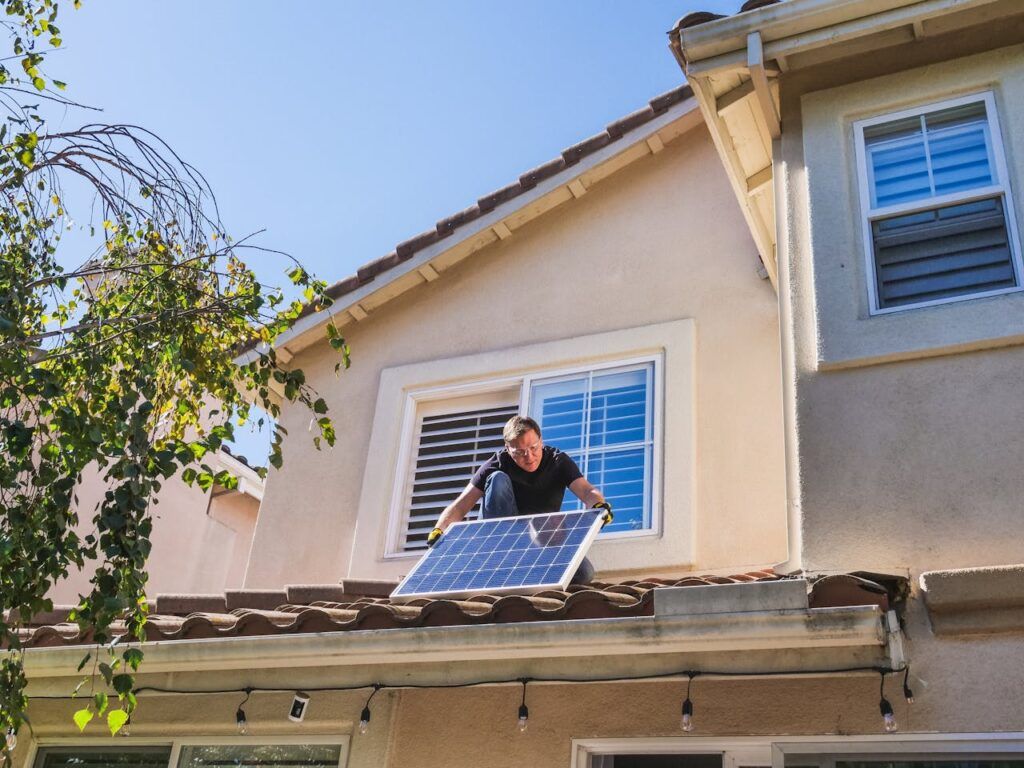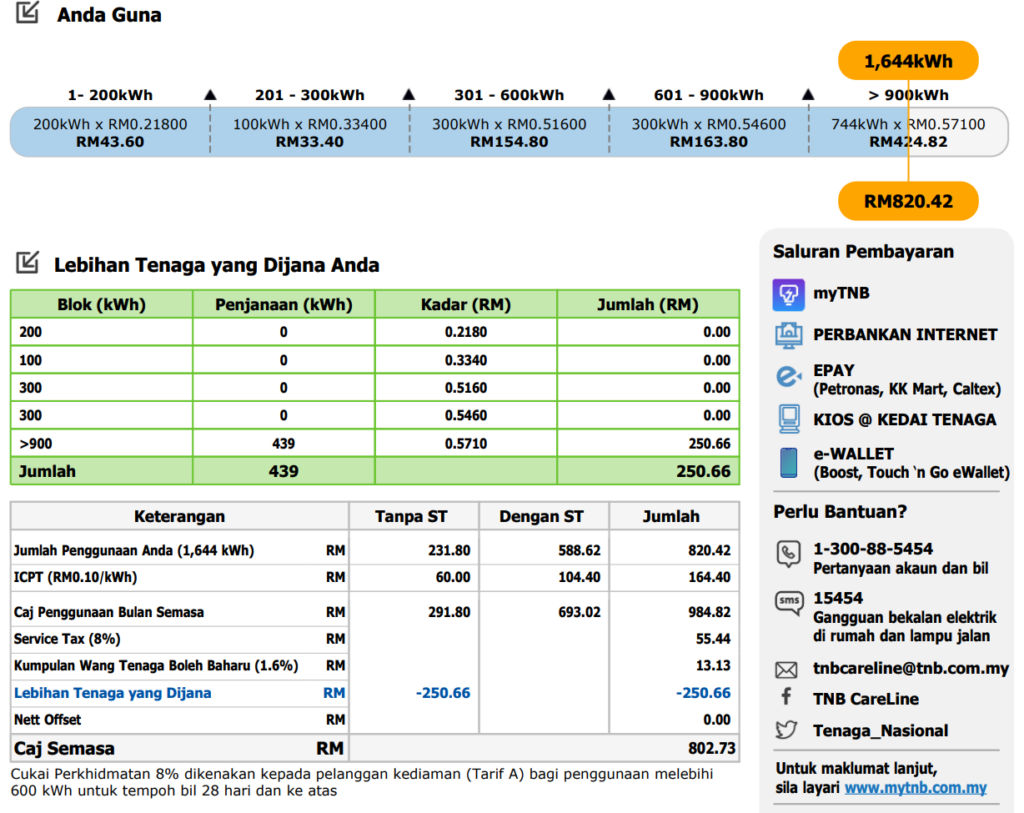Table of Contents
Introduction
Solar panels have gained popularity in Malaysia over the past few years, with many considering them to be a top-notch investment for residential properties. As of the time of writing, our government even offers incentives of RM4,000 for installing solar panels.
But the burning question remains: Are they truly worth the investment? The short answer: It depends.
Last year, we decided to install solar panels for our home, with a total cost of RM34,000. The vendor estimated that the system would generate approximately 949 kWh per month with 16 panels. After a few months of use, I believe it’s time for me to draw a conclusion on whether it’s worth the investment.
In this post, I’ll walk you through the process I used to decide on installing solar panels for our home, and whether they’ve proven to be worth it after several months of use. I’ll delve into how much money I’ve saved and consider any opportunity costs involved.
What Is Net Energy Metering (NEM) from SEDA?

Before diving into the decision-making process and crunching the numbers, let’s first understand the basics: how do solar panels actually help save money?
The concept is quite straightforward. During the day, the electricity produced by the solar panels powers all the devices in our home directly. Any excess electricity generated beyond what we consume is fed back into the power grid. In essence, when we generate more electricity than we use, we essentially become suppliers to TNB, selling back the surplus electricity to them.
At night, when the solar panels are not generating electricity due to the absence of sunlight, we rely on electricity supplied by TNB as usual. This arrangement is known as Net Energy Metering (NEM). Currently, we are under NEM 3.0, where the price at which we sell our excess electricity is directly offset against the highest tier pricing of our consumption.
Notice that there are no batteries involved? That’s because batteries come at a much higher cost, require more space, and may introduce fire hazards. So, instead of storing electricity in batteries, we use TNB as our “powerbank”.
Case Study: 6 Months After Solar Panel Installed

When we first decided to install solar panels, we talked to a few different solar panel providers and asked them to provide an estimation of the cost, monthly power generation, and types.
The solar panel package we got
After surveying a few different providers, we ended up with a provider that quoted us this package:
- RM34,000 (With 60 months instalment of RM566, which is important)
- 9.04 kWp (This mean the peak output at maximum working capacity can produce 9/kWh)
- 16 Solar Panels
- 4 Micro Inverter*
- Potential Monthly Electricity Generation is 950kWh
*Another vendor quoted us similar kWp packages at a higher price, but it utilized an inferior string inverter. We specifically avoided string inverters due to their higher susceptibility to fire hazards.
How to compare prices between solar panel vendor
I used the cost per kWp as a rough metric to compare the prices offered by different vendors. However, it’s important to note that this should only serve as a rough comparison because vendors may use different brands of panels, inverters, and offer varying warranty terms.
Another crucial factor is the potential monthly electricity generation, which necessitates a survey and calculation by an engineer. Variables like roof surface, roof angle, and house positioning can impact the maximum sunlight exposure for your solar panels. That’s why it’s advisable to consult multiple vendors for surveys to ensure you receive accurate estimates and avoid inflated figures that deviate significantly from the average.
Then you can obtain another metric for comparison, which is the cost per potential kWh generation. In our case, it’s calculated as RM34,000 divided by 950 kWh, resulting in RM35.79 per 1 kWh. With these two metrics, you can effectively evaluate which vendor offers the most cost-effective solution.
Results after 6 months
Here is the monthly electricity generated since we started using it from 9th Oct 2023:

Unfortunately, our solar panel wasn’t working from 22nd Jan to 16th Feb because the switch tripped, and we didn’t notice until later, resulting in about 26 days of wasted electricity from the solar panel.

Excluding the period when the solar panel wasn’t working, I calculated the daily average for the last 6 months, which encompassed about 188 days of data. The electricity generated per day averaged around 28.4 kWh, resulting in a monthly average of 851.87 kWh. This translates to a monthly savings of approximately RM486.42 to RM571.61.
The range is because we consume above 1500 kWh, triggering the ICPT surcharge of RM0.10 per kWh. However, during the day, we utilize the electricity generated by the solar panels, thereby avoiding the ICPT surcharge for that portion of usage. Conversely, electricity consumed at night, drawn from TNB, is subject to the surcharge.
Electricity Bill with Solar Panel
Here is our April 2024 electricity bill from TNB, let’s take a look at how to interpret it:

In the highlighted month, we consumed approximately 1,644 kWh from TNB. Conversely, our solar panels supplied 439 kWh back to TNB, which was sold at the highest tier rate of RM 0.571 per kWh due to our consumption exceeding 900 kWh. Consequently, we received RM250.66 rebate from TNB for the surplus electricity.
Additionally, since our consumption exceeded 1,500 kWh, we were subject to an ICPT surcharge of RM0.1 per kWh, amounting to RM164.4
You may have noticed that in the previous section, I mentioned that the total electricity generated in April was 880.76 kWh. So, why was only 439 kWh supplied back to TNB? That’s because the remainder was consumed by us, and the 430 kWh represented excess electricity that we didn’t need during the daytime.
In total we saved about RM547 in April 2024, and here’s the math:
- RM250.66 = 439kWh supplied to TNB
- RM252.26 = 441.76kWh generated and consumed during day time (RM0.571/kWh)
- RM44.18 = ICPT we saved from the 441.76kWh not being drawn from TNB
Bonus saving when below ICPT threshold
During rainy months or periods when we travel and are not at home for weeks, our electricity usage falls below 1,500 kWh. For instance, last year in October, November, and December, we actually received a rebate from ICPT at RM0.2/kWh


If we weren’t using solar panels, we would actually have to pay RM0.1/kWh instead of receiving a rebate from it. Unfortunately, TNB revised the ICPT to stop providing a rebate if you use more than 600 kWh, but we can still avoid ICPT by using less than 1,500 kWh during colder months.
So, if your monthly electricity usage is also around the ICPT threshold of 1,500 kWh, solar panels, which reduce some usage from your bill during daytime generation, may also help you save some extra money.
Is it worth it? Let’s do some math
Every month, we save around RM540, not including the potential savings of being completely exempt from ICPT during colder months or months we travel abroad. This means the estimated true savings are closer to RM600 per month.
And how much did we pay to save RM540 to RM600 per month? The monthly installment is RM565, which means if we look at our cash flow, we aren’t paying less every month. However, the difference is that once the installment is fully paid off in 5 years, we will be saving RM540 to RM600 per month.
The NEM 3.0 contract is signed for a 10-year period, which means TNB is guaranteed to buy back electricity supplied by us for the next 10 years.
Is it worth it? As of now the answer is obviously a yes.
Should You Invest in Solar Panels?
To us, it was a no-brainer because we don’t have to pay more than what we are already paying, and we get to enjoy additional savings after the 5-year installment is fully paid off. Plus, the additional savings from lowering our monthly usage to below the ICPT threshold is a bonus too.
Now we know solar panels can, in fact, help save money, but it’s not as straightforward. I recommend reaching out to a few vendors, getting some estimates on cost and potential savings, and exploring installment plans available, then do some calculations first before you move forward.
I hope this post gave you an idea about investing in solar panels and how they can potentially help you save money too. If I missed anything you believe I should mention or if you have any questions about investing in solar panels, please leave a comment and I’ll look into it.


Can you please share which vendor did you use for the Solar Panel?
I used pathgreeen it’s slightly more expensive than the others who use string inverters, but we chose to go with micro inverters to be more safe from fire hazards. Anyway I recommend you to survey a few solar supplier within your area maybe you can get even better deal and more understanding.